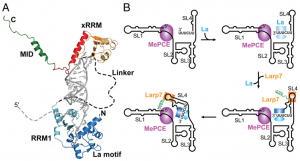DBCCR1
Contents
Annotated Information
Name
Approved symbol: BRINP1
Approved name: BMP/retinoic acid inducible neural specific 1
HGNC ID: HGNC:2687
Previous names: deleted in bladder cancer chromosome region candidate 1, deleted in bladder cancer 1, bone morphogenetic protein/retinoic acid inducible neural-specific 1
Previous symbols: DBCCR1, DBC1
Alias symbols: FAM5A
RefSeq ID: NM_014618
Characteristics
BRINP1 is a prototype member of the subsequently identified BRINP family of sequentially related neural-specific proteins including BRINP2 and BRINP3, located on chromosome 9q 32–33, a putative tumor suppressor locus whose deletion is frequently observed in bladder tumors((Toshiyuki N 2004)).
Expression
BRINP1 is most highly and widely expressed in various regions of the mammalian nervous system, although its expression is also found in some non-neural tissues and cell types at low levels((Toshiyuki N 2004)).
Regulation
Hypermethylation of the BRINP1-CpG island suppresses BRINP1 expression in NIH 3T3 cells((Toshiyuki N 2004)).
Function

7SK snRNA functions in transcriptional regulation by interacting with PTEF-B complex ((Nguyen 2001)) ((Yang 2001)), BAF chromatin-remodeling complex ((Flynn 2016)), or hnRNP R ((Briese 2018)). Consistently, it has been found highly enriched in isolated chromatin fractions, which may be related to its role in transcriptional regulation ((Mondal 2010)). In addition to its critical role for controlling transcription, 7SK snRNA is also involved in alternative splicing ((Barboric 2009)) and the localization of protein in nucleolus ((He 2007)). Therefore, 7SK snRNA has a variety of functions in the nuclear, playing important roles in cell growth and differentiation ((Nguyen 2001)) ((Yang 2001)), axon maintenance ((Briese 2018)) and vertebrate development ((Barboric 2009)).
7SK snRNA controls RNAP II activity by inhibiting P-TEFb elongation factor, which is a cdk-cyclin kinase that functions as both a general and an HIV-1 Tat-specific transcription factor ((Nguyen 2001)) ((Yang 2001)), with an impact on cell growth and differentiation. Specifically, 7SK snRNA functions as the central scaffold that coordinates protein-protein interactions and, by inhibiting P-TEFb kinase-mediated CTD phosphorylation, regulates RNAP II elongation ((Nguyen 2001)).
At an early stage of the HIV transcription cycle, elongation is prevented as P-TEFb is recruited to the HIV-1 promoter in a catalytically inactive state bound to the 7SK snRNP and also the Tat trans-activator of transcription protein. The inhibitory 7SK snRNP may be displaced by the nascent TAR HIV RNA that also binds Tat protein, activating P-TEFb kinase and transcriptional elongation ((D'Orso 2010)). Displacement of 7SK may also be performed by cellular RNAs, as indicated by the 3'-untranslated region (~300-nt) of HIC mRNA, which forms complexes with P-TEFb and is necessary and sufficient for stimulation of P-TEFb-dependent transcription of the HIV promoter ((Young 2007)).
7SK snRNA inhibits enhancer transcription by modulating nucleosome position. 7SK physically interacts with the BAF chromatin-remodeling complex, recruits BAF to enhancers and inhibits enhancer transcription by modulating chromatin structure ((Flynn 2016)).
In axons, 7SK snRNA interacts with hnRNP R to regulate its function in axon maintenance ((Briese 2018)).
7SK snRNP (composed of 7SK snRNA, Hexim1, Larp7/Pip7S, and the P-TEFb subunits CycT1 and Cdk9) is not only critical for controlling transcription, but also for regulating alternative splicing coupled to transcription elongation ((Barboric 2009)). 7SK snRNP disintegration promotes inclusion of an alternative exon via the increased occupancy of P-TEFb, Ser2-phosphorylated (Ser2-P) RNAPII, and the splicing factor SF2/ASF at the minigene ((Barboric 2009)).
7SK snRNA also inhibits APOBEC3C deaminase activity and sequesters it to the nucleolus, suggesting broader role for 7SK RNA in regulating key nuclear functions ((He 2007)).
Disease
colon adenocarcinoma [1]
Evolution
Please input evolution information here.
Labs working on this lncRNA
Please input related labs here.
References
- ↑ Shahriyari L. Effect of normalization methods on the performance of supervised learning algorithms applied to HTSeq-FPKM-UQ data sets: 7SK RNA expression as a predictor of survival in patients with colon adenocarcinoma. Brief Bioinform. 2017 Nov 3. doi: 10.1093/bib/bbx153.
Annotation originally sourced from lncRNAdb.
Basic Information
| Transcript ID |
NONHSAT113149 |
| Source |
NONCODE4.0 |
| Same with |
, |
| Classification |
intergenic |
| Length |
332 nt |
| Genomic location |
chr6+:52860418..52860749 |
| Exon number |
1 |
| Exons |
52860418..52860749 |
| Genome context |
|
| Sequence |
000001 GGATGTGAGG GCGATCTGGC TGCGACATCT GTCACCCCAT TGATCGCCAG GGTTGATTCG GCTGATCTGG CTGGCTAGGC 000080
000081 GGGTGTCCCC TTCCTCCCTC ACCGCTCCAT GTGCGTCCCT CCCGAAGCTG CGCGCTCGGT CGAAGAGGAC GACCATCCCC 000160 000161 GATAGAGGAG GACCGGTCTT CGGTCAAGGG TATACGAGTA GCTGCGCTCC CCTGCTAGAA CCTCCAAACA AGCTCTCAAG 000240 000241 GTCCATTTGT AGGAGAACGT AGGGTAGTCA AGCTTCCAAG ACTCCAGACA CATCCAAATG AGGCGCTGCA TGTGGCAGTC 000320 000321 TGCCTTTCTT TT |